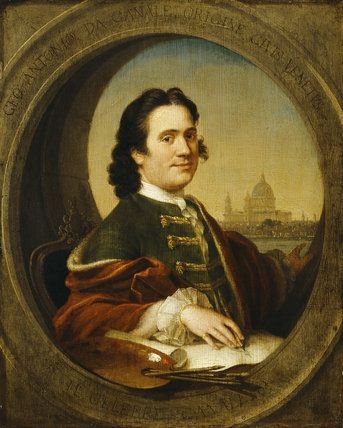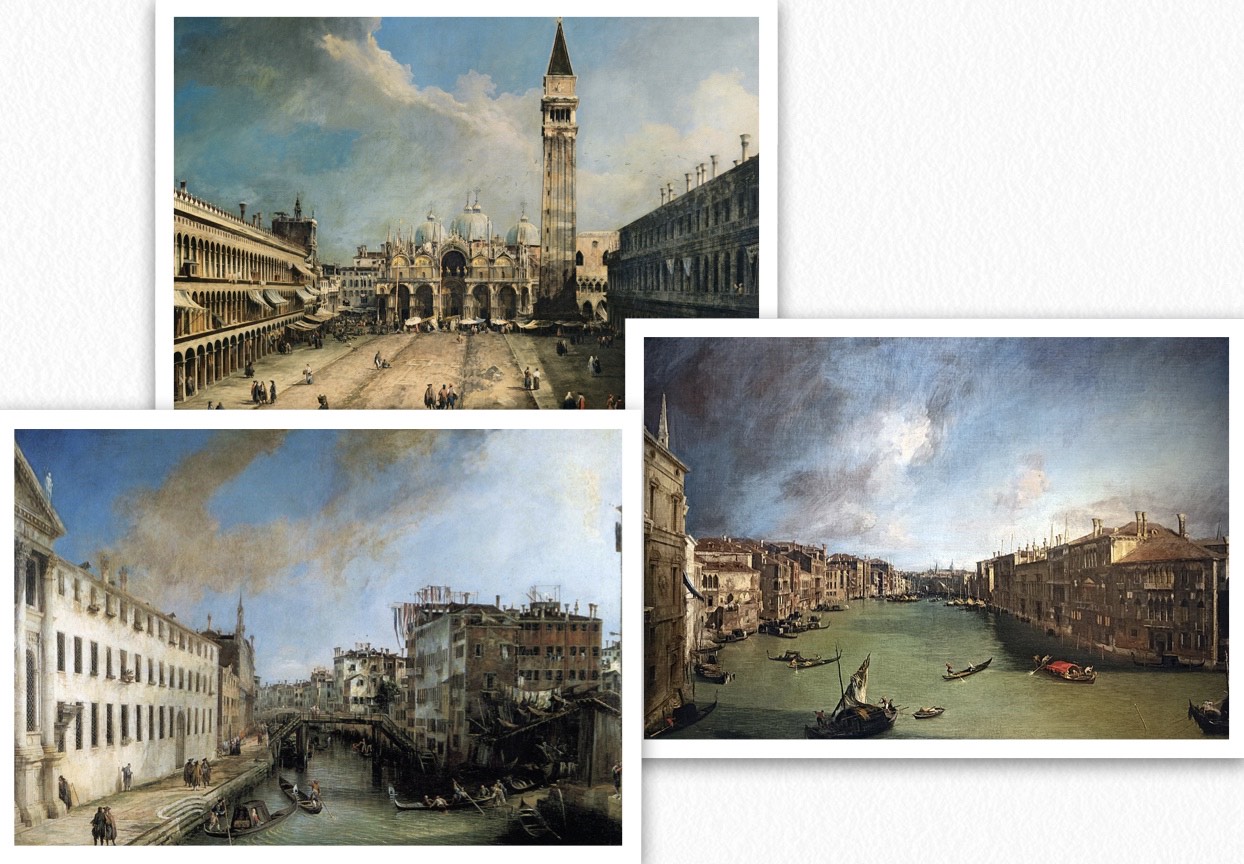Among the Venetian painters that we could immediately define as more anomalous, or rather unique within the panorama of the time, we certainly find the figure of Giovanni Antonio Canal better known as Canaletto (Venice 1697 - Venice 1768). An artist who became famous for being one of the key figures of Venetian Vedutismo, a pictorial current of the eighteenth century that gave It will give new dignity to landscapes, especially urban ones, compared to what happened in the past, reproducing them faithfully and following strict rules of perspective.
The man and the artist

Born into a wealthy family, Canaletto began with the help of his father, a theatre painter, to work in the field of scenography together with his brother Cristoforo. Theatrical commissions followed one another and the young followed his father to Rome for a business trip to the capital. He stayed there for about two years and was continually "distracted" by the stimuli coming from the artistic scene of the city. The theatre was evidently not in Antonio Canal's aspirations, so much so that his contemporary, Count Anton Maria Zanetti, his critic and admirer, described the then twenty-year-old as a boy who was perpetually bored by the opera and the scenes. After having definitively excommunicated the audiences in Rome he approached the landscape painting of Giovanni Paolo Pannini (Piacenza 1691 - Rome 1765) and especially that of the Dutchman Gaspar Van Wittell (Amersfoort 1653 - Rome 1736). Once he returned to his hometown he continued to take an interest in this type of subject, which at the time was already practiced by artists of the Venetian Republic such as Marco Ricci and Luca Carlevarijs, and only a few years later he surpassed it in terms of fame and fortune.
The refinement of the lines and the refinement of the atmospheres that Canaletto was able to recreate in his works attracted many English clients. Contacts with foreign personalities became more frequent also thanks to the Grand Tour, a trip taken by the richest of the time for reasons of cultural growth, and which found in Venice a stop not to be missed.
Among the key meetings in the Venetian artist's personal history are those with the Irish art dealer Owen McSwiney and later with the English diplomat Joseph Smith, British consul active in the city between 1744 and 1760. These were very prosperous years for the painter and this went on until the war of the Austrian succession (1740-1748) which drastically reduced the number of travellers, and consequently his profits. It was in this way that Canaletto decided to move to England, where he stayed for about 10 years, between 1746 and 1756, building other important relationships with the local aristocracy and enriching the quantity of his figurative subjects. The urban images of Venice were joined by those of London and not only that, but the countryside and the English moorland also became the object of studies for him: nature became the protagonist of this painting as never before.
The return to his hometown in 1756 was definitive, and in the last years of his life he was involved as a member of the Academy of Painting and Sculpture of Venice. He painted all his life, writing important pages for the history of Italian art, and died surrounded by the affection of his family in 1658, in his Venice.
Painting technique and significant works

Canaletto's works have long been the subject of bitter critical debate: he was judged negatively by historians and artists and then reinterpreted positively in more modern times.
He was often challenged for his excessive technicality and the use of the optical camera (or darkroom), a device made up of a perforated box that allows light to enter and is therefore capable of projecting the shadows of "reality" accurately. Most of his works show images of the Venetian city, its fields, its rivers, the Lagoon in an almost immutable analytical way. The viewer has the impression that nothing has changed, also thanks to the prevalence of landscape and architecture over its inhabitants.
Among the most fascinating works there is The Bucintoro at the pier on Ascension Day, now preserved in Turin, which represents the festive moment when the Bucintoro, the famous and glorious vessel on which Dogi moved, went to the Lagoon to celebrate the marriage of the city with the sea, underlining the dominion of the Republic over the Adriatic.
Another determining factor in Canaletto's art is his excellent quality as a draughtsman: in fact before proceeding with painting he used to make sketches faithful to the places where he worked, which he would later rework in the studio, meticulously defining characters and luminous atmospheres.
Remarkable the views of St. Mark's Square, painted many times with different atmospheres and details. Let's consider St. Mark's Square towards the Basilica of 1723, and today preserved in the Museum Thyssen-Bornemisza in Madrid, where we can see the work of replacing the paving of the square and the crowding of people in the market area near the basilica. A few years later we see the same subject, now preserved in Cambridge, in Massachusetts State, in which we notice a square rearranged from an architectural point of view and portrayed in bright and serene sky conditions.
Finally, all his "capriccio style" are enchanting, that is all those paintings, in this case with landscape and architectural subjects, the result of the author's imagination. He was also good at combining really existing elements with others that were the result of his creative flow. His Palladian capriccio of 1756, a work staged in Venice, as can be seen from the presence of gondolas and other local boats, but which combines the city with buildings in Vicenza such as Palazzo Chiericati and Basilica Palladiana. Funny to note that Antonio da Ponte's Rialto bridge is missing, and an alternative reality is being built, with Andrea Palladio's project taking shape, the only visual evidence of Palladio's participation in the competition for the construction of the new bridge.
Where to see Canaletto in Venice

Canaletto, the painter who painted Venice in all its forms, found so much fortune abroad that his greatest collections were sold to King George III of England who included them in the Royal Collection, now kept in royal residences across the Channel.
But in your city, in our Venice, you can admire the artist at the Accademia Gallery, exposing The perspective with porch, 1756 and which exhibits some of his whims, and in the Drawings and Prints Cabinet of the same institution, which houses some of his most remarkable graphic works.
At the 18th century Venetian museum in Ca' Rezzonico you can admire the paintings of his pre-English phase, with some of his famous views of the city: the portego on the second floor, in fact, are dominated by two magnificent canvases by the young Canaletto, namely The Grand Canal from Palazzo Balbi to Rialto and Rio dei Mendicanti, two youthful masterpieces of two splendid Venetian views, in which the artist enlarging the size of the Grand Canal wants to enhance the characteristic of Venice as a city of water.
In the Palazzo della Collezione Cini, in the Dorsoduro District, there is a painting of his pre-English phase and two whims with ruins dating back to his youth.
To find oneself in front of a canvas by Canaletto means being able to immerse oneself in the wonderful Venice of the eighteenth century, a shining and glorious era, looking at the city with the eyes of the extraordinary painter: an emotion that only the great artist's brushstrokes can give us!










Lascia un commento